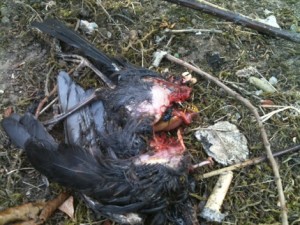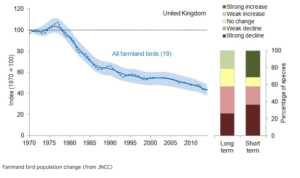Prof. Dave Goulson’s reply to Dr. Chris Hatfield of the National Farmer’s Union
Carrion
Having walked many miles throughout farmlands, woodlands, marshes and the wider countryside, to be honest its not that often I find many dead birds or other animals for that matter. Nature deals with carrion which is an important food resource for many animals, birds, fly maggots, other insects and/or their larvae and of course microbes. The carrion is broken down over time and recycled whether it is directly to the soil or as fat reserves on larger scavengers.
We have a bird called the Carrion Crow and even social and even social wasps eat dead birds! No wonder we don’t see dead animals or birds that often. See RSPB Where do birds go when they die?
Senior regulatory affairs adviser at the NFU states evidence from real life field situations did not back up the claims, which he states are Prof. Goulson theories about neonicotinoids poisoning birds are simply that, theories.
Judge who is right for yourselves.
Philip Lymbery, chief executive of Compassion in World Farming, has just launched his new book “Dead Zone: Where the Wild Things Were.” In it, he suggests that neonicotinoid insecticides may be contributing to bird declines. This claim has come under heavy fire from NFU and the agrochemical industry. In a recent online article NFU’s Dr Chris Hartfield is quoted as saying:
“Evidence from real life field situations did not back up the claims, which are based on research by Dave Goulson, Professor of biology at Sussex University. Professor Goulson has published a paper which claimed a grey partridge would be killed by eating five treated seeds, and a sparrow after two. He also said birds which ate insects were ‘declining more rapidly in areas which use neonics’.
“Dave Goulson’s theories about neonicotinoids poisoning birds are simply that – theories – and are not backed up by evidence from real life”, he added. In the UK, poisoning of all animals is investigated by the Wildlife Incident Investigation Scheme. If seed-eating farmland birds were being poisoned as a result of eating neonicotinoid treated seed, you would rightly expect this scheme to be finding these incidents. There are no incidents of bird poisoning resulting from the use of neonicotinoids over the last ten years. Promoting theories without the evidence to back them up is only going to damage the cause of pollinators and wildlife, and damage the public perception of science in general.”
The paper to which Dr Hartfield refers was a review I published in 2013 in Journal of Applied Ecology (Goulson 2013).
In it, I say the following:
“Although neonicotinoids do show relatively low toxicity to vertebrates, we might expect seed-eating vertebrates to be exposed to lethal doses if they consume treated seeds spilled during sowing. Typically, maize seeds are each treated with ~1 mg of active ingredient, beet seeds with 0.9 mg, and the much smaller oilseed rape seeds with 0.17mg (Rexrode et al. 2003; Anon 2012; Krupke et al. 2012). A grey partridge, typically weighing approximately 390g, therefore needs to eat ~5 maize seeds, 6 beet seeds or 32 oilseed rape seeds to receive an LD50. A grey partridge typically consumes ~25 g of seeds /day (Liukkonen-Anttila et al. 1999), equivalent to ~600 maize seeds, so clearly there is the potential for birds to swiftly consume a lethal dose.
By a similar calculation, 3 maize seeds treated with imidacloprid would deliver more than the LD50 to a mouse. The US Environmental Protection Agency estimate that ~1% of drilled seeds remain accessible to granivorous vertebrates (i.e. they are not buried during drilling), and this does not include spillages which may occur, for example when transporting grain or loading hoppers. With typical sowing rates of ~50,000 seeds/ha for maize and 800,000 seeds/ha for oilseed rape, we might expect sufficient seed to be available on the soil surface to deliver an LD50 to 100 partridge or 167 mice for every hectare sown.
Lopez-Antia et al. (2013) fed imidacloprid-dressed wheat seed to red-legged partridge (Alectoris rufa) for 10 days and obtained 58% mortality, with the survivors exhibiting a range of sublethal effects. This mortality rate, although considerable, is less than we might expect from the calculations above. Lopez-Antia et al. report anecdotally that partridge did not avoid dressed seed when offered both dressed and undressed, but speculate that treated birds ate less than control birds, and so received a lower dose than expected. This requires further investigation, in this and other species, to determine how much treated seed vertebrates actually consume in the field. De Snoo et al. (1999) describe incidents of poisoning of wild partridge, pigeon and duck by seed dressed with imidacloprid reported by members of the public in France in 1994-5 (a time when neonicotinoid use was very low), but other evidence for effects in the field is lacking and it is unclear whether public reporting is an efficient means of detecting such incidents.”
Since 2013, there have been a number of other scientific publications linking neonicotinoids to declines of birds and other vertebrates, most of which are reviewed here. I would draw your attention to two in particular. Firstly, in a high profile paper in the journal Nature, Hallmann et al. (2014) demonstrate that geographic patterns of declines of insect-eating birds in the Netherlands are explained by local levels of environmental pollution with the neonicotinoid imidacloprid. They conclude that this is unlikely to be due to direct toxicity, but that it is probably simply that in areas where insecticide use is high there are few insects for the birds to eat. Seems pretty plausible to me.
Secondly, a recent study of bird poisoning incidents in France shows that, between 1995 and 2014, there were 101 incidents involving 734 dead animals in which toxicological reports detected imidacloprid, and where the death is likely to be associated with agricultural use of seed treatments. 70% of these incidents happened during autumn cereal sowing. Grey partridges and various pigeon species were the ones most frequently killed.
According to Dr Hartfield, there have been no such incidents in the UK. This strikes me as very odd. Farming in France is very similar to the UK; most of the same crops are grown, and pesticide uses are very similar. I rang the UK Wildlife Incident Investigation Scheme to ask them whether they actually test dead birds for neonicotinoids. The person I spoke to did not know, and asked me to send in an email request, which I have done. When I get a reply, I’ll update the blog.
So, Dr Hartfield, my theories are more than “just theories”. “Real life” evidence from the Netherlands and France strongly supports them. The absence of direct evidence from the UK should not be interpreted as evidence of absence – if you don’t look for something, you won’t find it.
The ongoing complacency of NFU, and their willingness to aggressively attack scientists who speak out against overuse of pesticides does them no credit. Farming bird populations are collapsing, along with most other farmland wildlife. Isn’t it time the NFU faced up to this, and took some responsibility?
“All my articles and videos, available free, are funded by my teaching and sales of award winning bumblebee nest boxes, solitary bee boxes, and wormeries. Please help by spreading the word and forwarding this link to your friends and colleagues. https://nurturing-nature.co.uk Thank you” George Pilkington
Refs.
Goulson, D. 2013. An overview of the environmental risks posed by neonicotinoid insecticides. JOURNAL OF APPLIED ECOLOGY 50: 977-987.
Original article Sussex University



Recent Comments